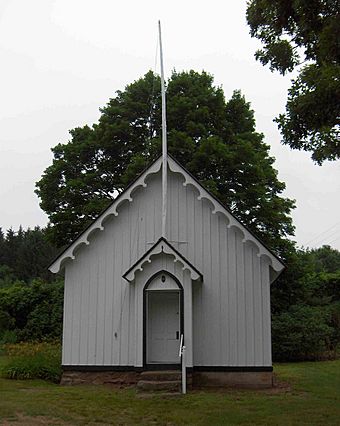Pine Grove Historic District (Avon, Connecticut) facts for kids
Quick facts for kids |
|
|
Pine Grove Historic District
|
|
 |
|
| Location | West Avon and Harris Rds., Avon, Connecticut |
|---|---|
| Area | 121 acres (49 ha) |
| Built | 1789 |
| Built by | Tefft, Thomas A.; Multiple |
| Architectural style | Greek Revival, Italianate, Gothic Revival |
| NRHP reference No. | 80004066 |
| Added to NRHP | February 11, 1980 |
The Pine Grove Historic District is a special area in Avon, Connecticut. It's like a time capsule, showing us what life was like in the 1800s. This district has many old farmhouses and a historic school building. You can find it around the meeting point of West Avon and Harris Roads.
The district includes four farmhouses from the 1800s. One house is even older, built in the 1700s! The famous Pine Grove School, built in 1865, is also part of this area. Because of its important history, the district was added to the National Register of Historic Places in 1980.
What is a Historic District?
A historic district is a group of buildings, structures, or sites that are important to history. They are often protected to keep their original look and feel. The Pine Grove Historic District helps us remember the past of Avon.
Avon's Early History
The town of Avon became its own town in 1830. Before that, it was part of Farmington. Much of the land was used for farming. People who lived in Farmington village would work these farms.
In the 1800s, farming in the area started to change. Farmers began growing "cash crops" instead of just enough food for themselves. This meant they grew crops to sell, like tobacco.
Two important families, the Thompson and Woodford families, owned a lot of land. They were among the first to build houses on their farms in this area.
Exploring the Old Buildings
The Pine Grove Historic District stretches along West Avon Road. It goes between Thompson Road and Harris Road. The Pine Grove School is at the corner of West Avon and Harris Roads.
Just southeast of the school, on Harris Road, is the David Rood House. This house was built in 1820. It marks the southern end of the district.
The district has five old farmhouses. All of them are made of wood and have clapboard siding. They were built between 1789 and 1856. Each house has a different style. For example, the Woodford House shows the Federal style. The Thompson house has an Italianate style. The Pine Grove School stands out with its unique Gothic style.



